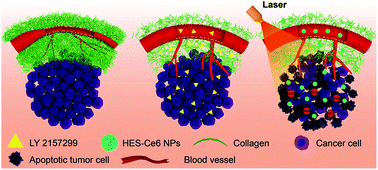Transforming growth factor-β blockade modulates tumor mechanical microenvironments for enhanced antitumor efficacy of photodynamic therapy†
Abstract
Photodynamic therapy (PDT) is frequently used in cancer treatment in clinical settings. However, its applications in stroma-rich solid tumors, e.g., triple negative breast cancer, are limited by abnormal mechanical microenvironments. Solid stress accumulated in stroma-rich solid tumors compresses tumor blood vessels, hampers the delivery of photosensitizers (PSs) in tumor tissues, and poses a major challenge for potent PDT. Here, we report a novel combination strategy to augment PDT based cancer therapy by combining hydroxyethyl starch–chlorin e6 conjugate self-assembled nanoparticles (HES–Ce6 NPs) with the transforming growth factor-β (TGFβ) inhibitor LY2157299 (LY). HES–Ce6 conjugates, as synthesized by one step esterification reaction, could self-assemble into uniform HES–Ce6 NPs, which exhibited enhanced photostability and generated more reactive oxygen species (ROS) under 660 nm laser irradiation than free Ce6. Prior to PDT, intragastric administration of LY decreased collagen deposition, alleviated solid stress, and decompressed tumor blood vessels. As a result, the reconstructed tumor mechanical microenvironment promoted accumulation and penetration of HES–Ce6 NPs into tumor tissues, contributing to augmented antitumor efficacy of HES–Ce6 NP mediated PDT. Modulating tumor mechanical microenvironments using TGFβ blockade to enhance the delivery of PSs in tumors with excessive extracellular matrix represents an efficient strategy for treating stroma-rich solid tumors.

- This article is part of the themed collection: 2021 Nanoscale HOT Article Collection


 Please wait while we load your content...
Please wait while we load your content...